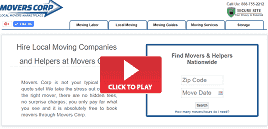How To Load and Pack a Storage Unit
How to Book a Mover

Guide to packing a portable storage container. There are a few things you should do to make sure your container is properly packed and secured.
How to Pack a Container
Even though we all enjoy a little additional freedom during the summer, going back to school means seeing old friends and moving closer to graduation. Before returning to school, keep in mind the following.
Back to College Move-in Tips
Renters insurance is a coverage that is specially designed in order to serve as a protection of renters; Find out if your possessions are covered by renters insurance when moving.
Does Renters Insurance Cover Moving?
Moving to college is a funny and thrilling experience. Here is a guide for the students getting ready to move.
Student Movers
Unlike local moves, long distance moves are charged by the weight. Use this tool to calculate the weight of the items you plan to move.
Moving Weight Calculator
Guide to Packing and Loading a Storage Unit
Packing a storage unit is an art form of sorts; you will have to put some thought into it if you want to make the most out of the limited space and keep your items protected from damage. Here are some tips on how to pack a storage unit.
AccessibilityOne of the best things about a self-storage facility is that you can access your items anytime you want, and you can make things easier if every item is properly accounted for. Make sure that each box is properly labeled. You can then make a list of the items in each box for easy reference.
At the planning stage, you should assess the items and determine if there are items that you may need to access frequently. Place them near the front of the storage unit. You might also want to consider leaving a narrow aisle in the middle so you could easily access the items at the back should you need to; this is especially recommended for larger storage units.
Protective MeasuresSelf-storage companies offer clean units but if you are worried that the floor space may not remain clean enough over time, you could place cardboard or wooden pallets on the floor. This could also help protect your items from damage. You may also use hollow spaces such as furniture drawers for fragile items. If you are going to store furniture on top of each other, dust sheets and other protective covers such as moving pads could help minimize scratches and damage. Seal the boxes with packing tape to prevent dust accumulation inside boxes.
Metal items should be covered by protective sheets to keep them from causing damage to other items. It is also best to wipe them with a little oil prior to storage to avoid rust formation. Electronic equipment such as computers and TVs should be packed in their original boxes as much as possible. If that cannot be done, they should at least be packed inside similar boxes. If you are going to store items that contain fuel such as lawnmowers, note that you will be asked to drain the tanks before putting them in storage.
Self-storage facilities are generally made to be moisture-resistant but if you want to be completely sure that your items would be safe, place moisture absorbents. You may also want to place vermin bait.
PlacementHeavy and bulkier items such as furniture should be stored first and placed at the back. It would be easier for you to make room for smaller items later anyway. Flat items should be made to rest against the wall. Avoid storing an item vertically if it appears wobbly.
Heavy items should be placed at the bottom and lighter items go up top. As a general rule, you should not stack more than 5 boxes or anything higher than what you can easily reach out for.
Maximizing SpaceIf you are going to store hollow items such as washers, dressers, and wardrobes, see if you could place smaller items inside to maximize the available space. Chairs can be stacked to save space.
If you want to save more space, you can dismantle furniture such as tables and bed frames. Just keep the nuts and bolts organized; place them in a properly-labeled plastic bag and have the bag taped to the furniture. Wrap the furniture sections to prevent damage and keep them together.
Just remember this when packing the storage unit: Use the shape of the item to your advantage. In fact, packing a storage unit would be a bit like putting a jigsaw puzzle together.
Find Storage Units in Your State
Copyright © 2008-2025 Local Movers Corp All rights reserved 1-888-755-2212
